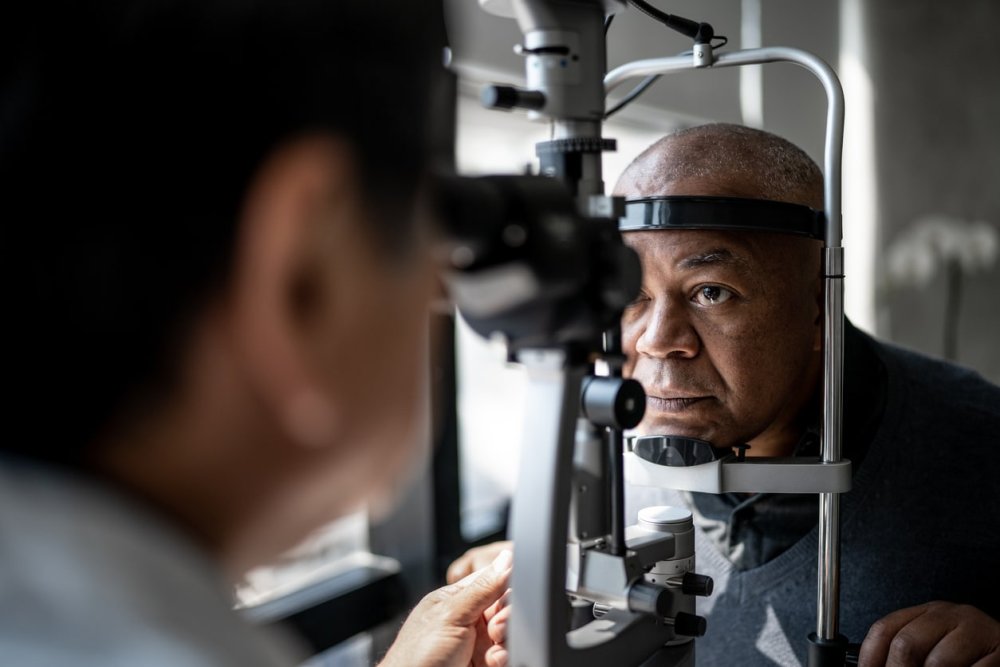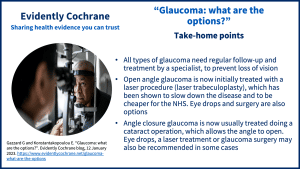In this blog, Professor Gus Gazzard, a glaucoma consultant and president of the UK & Éire Glaucoma Society, and Evgenia Konstantakopoulou, an optometrist specialising in glaucoma, explore the evidence on treatmentSomething done with the aim of improving health or relieving suffering. For example, medicines, surgery, psychological and physical therapies, diet and exercise changes. options for different types of glaucoma.
Take-home points
What is glaucoma?
Glaucoma is a disease that affects the optic nerve, the nerve that transmits signals from the eye to the brain. There is more than one type of glaucoma, but all of them need treatment to prevent loss of vision.
Most people with glaucoma have high eye pressure, but some will have glaucoma despite their eye pressure being normal. To maintain normal eye pressure your eyes produce a fluid, which is then drained by a special location inside your eye, the drainage angle. Different people will have glaucoma for different reasons. For example, because the drainage angle is not open enough (angle closure) or because the drainage angle is open but cannot drain the fluid efficiently (open angle).
Your eye doctor or optometrist will discuss the treatment options available to you, depending on the type of glaucoma you have. It is important you go to your regular check-up by your eye doctor or optometrist to ensure your treatment is working and your optic nerve is not getting worse.
What treatments are available for open angle glaucoma?
The main treatment available for all types of glaucoma is to lower the eye pressure, as this protects the optic nerve from damage. Eye pressure can be lowered in several ways:
Having a laser treatment
Laser trabeculoplasty can reduce eye pressure as good as eye drops and may work better than eye drops in slowing down the disease; it is safe and cheaper than eye drops for the NHS.1-3 When done in the NHS the treatment can be performed by eye doctors or other health professionals, such as optometrists or nurses.4
Using eye drops
Eye drops have been used to control eye pressure for decades; there is more than one type of eye drops that can reduce eye pressure. Eye drops need to be used one or more times per day and should not be stopped. Not all people will use the same eye drops, as this depends on peoples’ general health, allergies, and other characteristics.
Having surgery
There are three main types of glaucoma surgery, which are often performed when the eye pressure cannot be controlled with laser or eye drops.
Standard glaucoma surgery (trabeculectomy): This surgery is usually done when the eye pressure cannot be controlled with eye drops or laser. Following surgery, you will have to take some time off work, visit your eye doctor regularly and use eye drops for a few weeks. There is evidence suggesting that this type of surgery could be done as initial treatment when glaucoma is already advanced; this can control eye pressure better than eye drops, but is associated with more eye discomfort5,6.
Tube surgery: In this type of surgery a small tube is inserted in the drainage angle to facilitate fluid drainage. It is uncertain if this is more effective or safer than standard surgery for glaucoma7; it is usually the surgery of choice in cases where glaucoma is caused by another condition or when standard surgery has not been successful. Following surgery, you will have to take some time off work, visit your eye doctor regularly and use eye drops for at least a few weeks.
Minimally invasive glaucoma surgery: This type of surgery is not as invasive as other surgeries and is usually done alongside a cataract surgery. It uses a small device that opens the drainage angle and helps the fluid drain. There is currently no high-quality evidence on how good this type of surgery is compared to drops or standard surgery, but reports show certain devices are efficient and safe.8
What treatments are available for angle closure glaucoma?
The evidence available to us says that people with angle closure glaucoma might benefit from a cataract surgery; this is because by removing the cataract the drainage angle will open. This will offer better eye pressure control, fewer eye drops and better quality of life for the patients, compared to having a laser treatment.9 A cataract surgery for the treatment of angle closure glaucoma will also be cheaper for the NHS. There may be some cases where angle closure glaucoma is better treated with medication, laser or glaucoma surgery; your eye doctor will discuss the available options with you.
Find out more
- Glaucoma UK
- NHS Glaucoma
- The NHS has Decision Support Tools online to help you consider your treatment choices, including one on Making a decision about open-angle glaucoma
Disclosure of interests:
Gus Gazzard discloses research funding / research support from: NIHR-HTA, NIHR-EME, NIHE-RfPB, MRC (EAGLE trialClinical trials are research studies involving people who use healthcare services. They often compare a new or different treatment with the best treatment currently available. This is to test whether the new or different treatment is safe, effective and any better than what is currently used. No matter how promising a new treatment may appear during tests in a laboratory, it must go through clinical trials before its benefits and risks can really be known.), City University, European Glaucoma Society, Fight for Sight, British Council for Prevention of Blindness, Moorfields Eye Charity, Friends of Moorfields Charity, IGA-UK Royal College of Ophthalmologists, UKEGS, US-NIH (NEI). Also Non-Financial Disclosures: positions held in BCPB, UKEGS, EVICR, EGS, Glaucoma-UK
Evgenia Konstantakopoulou discloses grants from Moorfields Eye Charity and the NIHR, and lecture fees from AbbVie.
Gus Gazzard’s biography is below. You can view Evgenia Konstantakopoulou’s biography here.



